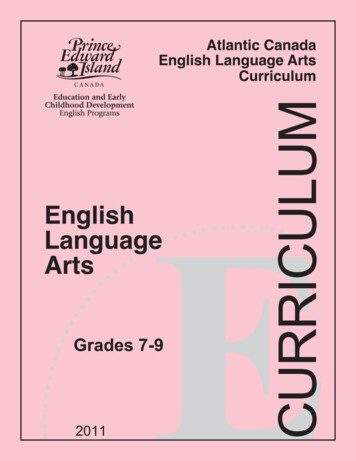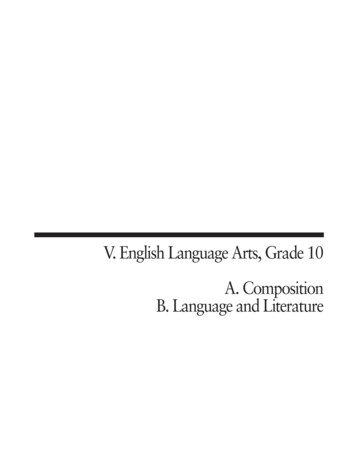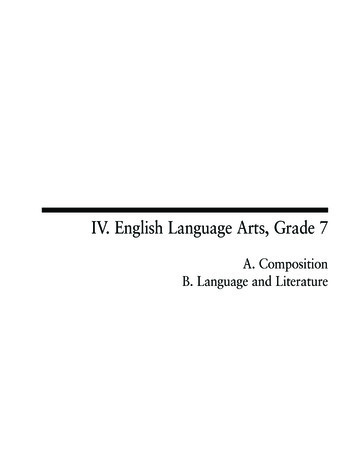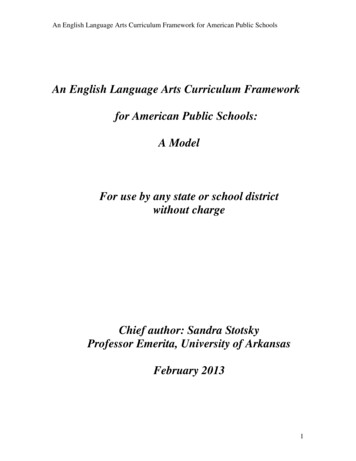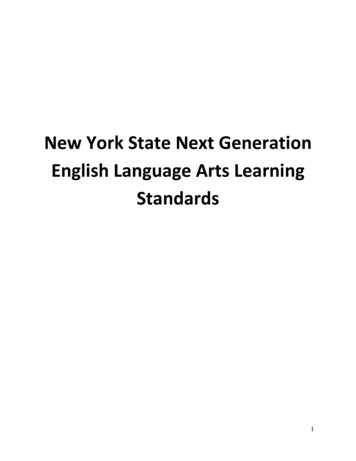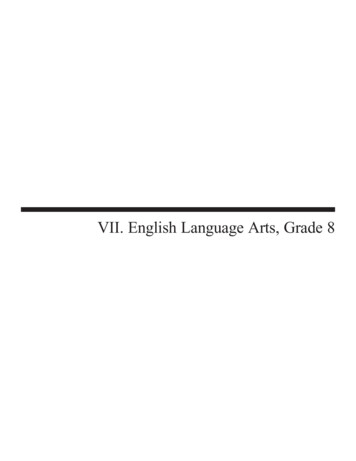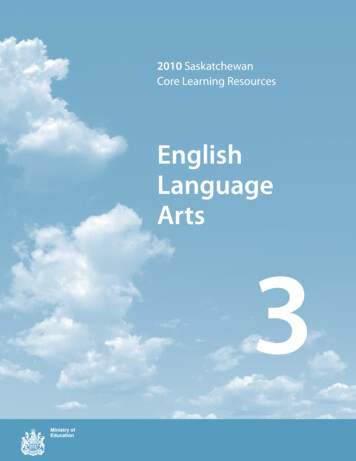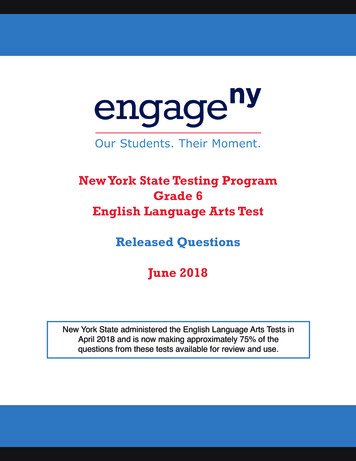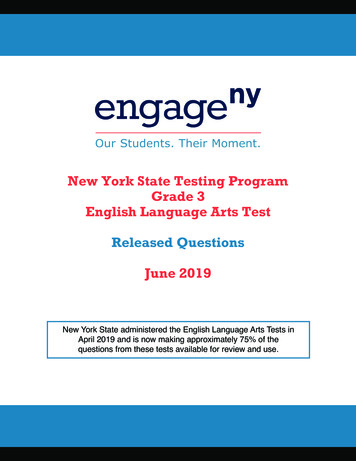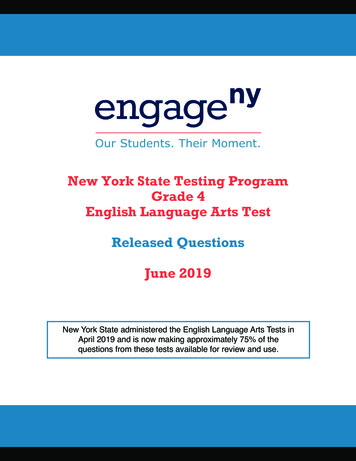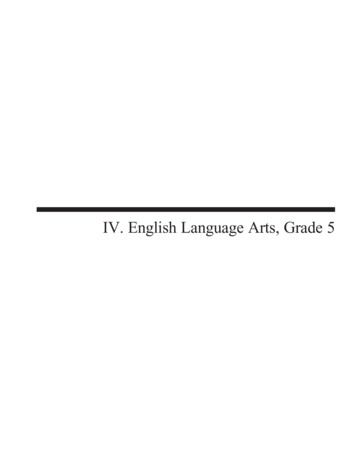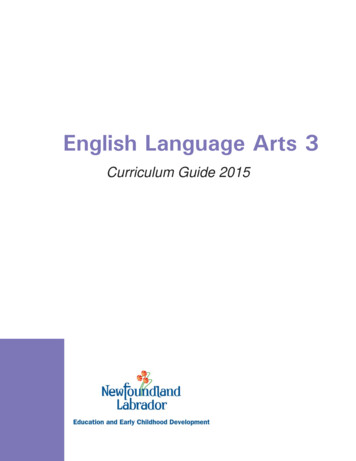
Transcription
English Language Arts 3Curriculum Guide 2015
MISSION STATEMENTDepartment of Education and EarlyChildhood DevelopmentMission StatementBy March 31, 2017, the Department of Education andEarly Childhood Development will have improvedprovincial early childhood learning and the K-12education system to further opportunities for thepeople of Newfoundland and Labrador.ENGLISH LANGUAGE ARTS 3 CURRICULUM GUIDE 2015I
IIENGLISH LANGUAGE ARTS 3 CURRICULUM GUIDE 2015
TABLE OF CONTENTSTable of ContentsAcknowledgements . vSection One: Newfoundland and Labrador CurriculumOutcomes Based Education. 1Context for Teaching and Learning . 4Inclusive Education. 4Literacy . 10Learning Skills for Generation Next . 12Assessment and Evaluation . 15Section Two: Curriculum DesignRationale . 19Curriculum Outcomes Framework . 20Course Overview. 23Suggested Yearly Plan . 24How to use a Four Column Layout. 26How to use a Strand Overview. 28Section Three: Specific Curriculum OutcomesSpeaking and Listening . 29Reading and Viewing . 57Writing and Representing. 95Appendices . 123References . 167ENGLISH LANGUAGE ARTS 3 CURRICULUM GUIDE 2015III
IVENGLISH LANGUAGE ARTS 3 CURRICULUM GUIDE 2015
ACKNOWLEDGEMENTSAcknowledgmentsThe Department of Education and Early Childhood Development for Newfoundland and Labradorgratefully acknowledges the contribution of the following members of the English Language Arts 3Working Group Committee, in the completion of this work:Cathy AuHumber ElementaryLisa Randell-DaweElizabeth Park ElementaryCharmaine Burt-SaundersParadise ElementaryLori DickerJens Haven MemorialCheryl SmithIndian River AcademyLynn AndrewsA.P. Low PrimaryDebbie SacreyJ.J. Curling ElementaryMichelle PowerDepartment of Education and Early ChildhoodDevelopmentDennis BarrowNewfoundland and Labrador English SchoolDistrictElizabeth GuyTricentia AcademyHeather OatesSt. James All GradeJohn BarringtonRoncalli ElementaryKathleen KindenGander AcademyKelly GarrettGander AcademyKim DeckerElizabeth Park ElementaryLisa PierceyMary Queen of Peace ElementaryENGLISH LANGUAGE ARTS 3 CURRICULUM GUIDE 2015Neva BeaupréElwood ElementaryNicole KellyNewfoundland and Labrador English SchoolDistrictPenny PinsentSt. Mary’s ElementarySarah RobbinsLumsden AcademySusan PowerWoodland PrimaryTenniel VincentHelen Tulk ElementaryTheresa BryantSt. Peter’s Elementary, Mount PearlValerie WellsBishop Abraham ElementaryV
VIENGLISH LANGUAGE ARTS 3 CURRICULUM GUIDE 2015
Section One:Newfoundland and Labrador CurriculumIntroductionThere are multiple factors that impact education including:technological developments, increased emphasis on accountability,and globalization. These factors point to the need to considercarefully the education our children receive.The Newfoundland and Labrador Department of Education believesthat curriculum design with the following characteristics will helpteachers address the needs of students served by the provinciallyprescribed curriculum: Curriculum guides must clearly articulate what students areexpected to know and be able to do by the time they graduatefrom high school. There must be purposeful assessment of students’performance in relation to the curriculum outcomes.Outcomes BasedEducationThe K-12 curriculum in Newfoundland and Labrador is organizedby outcomes and is based on The Atlantic Canada Framework forEssential Graduation Learning in Schools (1997). This frameworkconsists of Essential Graduation Learnings (EGLs), GeneralCurriculum Outcomes (GCOs), Key Stage Curriculum Outcomes(KSCOs) and Specific Curriculum Outcomes (SCOs).Essential Graduation Learnings(common to all subject areas)General Curriculum Outcomes(unique to each subject area)Key Stage Learning Outcomes(met by end of grades 3,6,9 and 12)Specific Curriculum Outcomes(met within each grade level and subject area)EssentialGraduationLearningsEssential Graduation Learnings (EGLs) provide vision for thedevelopment of a coherent and relevant curriculum. The EGLs arestatements that offer students clear goals and a powerful rationalefor education. The EGLs are delineated by general, key stage, andspecific curriculum outcomes.ENGLISH LANGUAGE ARTS 3 CURRICULUM GUIDE 20151
SECTION ONE: NEWFOUNDLAND AND LABRADOR CURRICULUMEGLs describe the knowledge, skills, and attitudes expected ofall students who graduate from high school. Achievement of theEGLs will prepare students to continue to learn throughout theirlives. EGLs describe expectations, not in terms of individual subjectareas, but in terms of knowledge, skills, and attitudes developedthroughout the curriculum. They confirm that students need to makeconnections and develop abilities across subject areas if they areto be ready to meet the shifting and ongoing demands of life, work,and study.Aesthetic Expression - Graduates will be able to respond withcritical awareness to various forms of the arts and be able toexpress themselves through the arts.Citizenship - Graduates will be able to assess social, cultural,economic, and environmental interdependence in a local and globalcontext.Communication - Graduates will be able to think, learn, andcommunicate effectively by using listening, viewing, speaking,reading, and writing modes of language(s), and mathematical andscientific concepts and symbols.Problem Solving - Graduates will be able to use the strategies andprocesses needed to solve a wide variety of problems, includingthose requiring language, and mathematical and scientific concepts.Personal Development - Graduates will be able to continue tolearn and to pursue an active, healthy lifestyle.Spiritual and Moral Development - Graduates will demonstrateunderstanding and appreciation for the place of belief systems inshaping the development of moral values and ethical conduct.Technological Competence - Graduates will be able to usea variety of technologies, demonstrate an understanding oftechnological applications, and apply appropriate technologies forsolving problems.2ENGLISH LANGUAGE ARTS 3 CURRICULUM GUIDE 2015
SECTION ONE: NEWFOUNDLAND AND LABRADOR CURRICULUMCurriculum OutcomesCurriculum outcomes are statements that articulate what studentsare expected to know and be able to do in each program area interms of knowledge, skills, and attitudes.Curriculum outcomes may be subdivided into General CurriculumOutcomes, Key Stage Curriculum Outcomes, and SpecificCurriculum Outcomes.General Curriculum Outcomes (GCOs)Each program has a set of GCOs which describe what knowledge,skills, and attitudes students are expected to demonstrate as aresult of their cumulative learning experiences within a subject area.GCOs serve as conceptual organizers or frameworks which guidestudy within a program area. Often, GCOs are further delineatedinto KSCOs.Key Stage Curriculum Outcomes (KSCOs)Key Stage Curriculum Outcomes (KSCOs) summarize what isexpected of students at each of the four key stages of GradesThree, Six, Nine, and Twelve.Specific Curriculum Outcomes (SCOs)SCOs set out what students are expected to know and be able todo as a result of their learning experiences in a course, at a specificgrade level. In some program areas, SCOs are further articulatedinto delineations. It is expected that all SCOs will be addressedduring the course of study covered by the curriculum guide.EGLs to CurriculumGuidesEGLGCOSubject AreaKSCOGrades 3, 6, 9& 12SCOCourse/Level4 Column SpreadsOutcomesENGLISH LANGUAGE ARTS 3 CURRICULUM GUIDE 2015Focus forLearningTeaching andAssessmentStrategiesResources andNotes3
SECTION ONE: NEWFOUNDLAND AND LABRADOR CURRICULUMContext for Teaching and LearningTeachers are responsible to help students achieve outcomes.This responsibility is a constant in a changing world. As programschange over time so does educational context. Factors that makeup the educational context in Newfoundland and Labrador today:inclusive education, support for gradual release of responsibilityteaching model, focus on literacy and learning skills in all programs,and support for education for sustainable development.Inclusive EducationValuing Equity andDiversityEffective inclusive schools have thefollowing characteristics: supportiveenvironment, positive relationships,feelings of competence, andopportunities to participate (TheCentre for Inclusive Education,2009).All students need to see their lives and experiences reflected intheir school community. It is important that the curriculum reflect theexperiences and values of all genders and that learning resourcesinclude and reflect the interests, achievements, and perspectives ofall students. An inclusive classroom values the varied experiences,abilities, social, and ethno-cultural backgrounds of all students whilecreating opportunities for community building. Inclusive policies andpractices promote mutual respect, positive interdependencies, anddiverse perspectives. Learning resources should include a rangeof materials that allow students to consider many viewpoints and tocelebrate the diverse aspects of the school community.attend tolearningpreferencespromotevaried stylesprovidevariedavenues andentry pointsto learningENGLISH LANGUAGE ARTS 3 CURRICULUM GUIDE 2015
SECTION ONE: NEWFOUNDLAND AND LABRADOR CURRICULUMDifferentiatedInstructionDifferentiated instruction is ateaching philosophy basedon the premise that teachersshould adapt instruction tostudent differences. Rather thanmarching students through thecurriculum lockstep, teachersshould modify their instruction tomeet students’ varying readinesslevels, learning preferences, andinterests. Therefore, the teacherproactively plans a variety ofways to ‘get it’ and expresslearning (Carol Ann Tomlinson).Curriculum is designed and implemented to provide learningopportunities for all according to student abilities, needs, andinterests. Teachers must be aware of and responsive to the diverserange of learners in their classes. Differentiated instruction is auseful tool in addressing this diversity.Differentiated instruction responds to different readiness levels,abilities, and learning profiles of students. It involves activelyplanning so that: the process by which content is delivered, theway the resource is used, and the products students createare in response to the teacher’s knowledge of whom he or sheis interacting with. Learning environments should be flexibleto accommodate various learning preferences of the students.Teachers continually make decisions about selecting teachingstrategies and structuring learning activities to provide all studentswith a safe and supportive place to learn and succeed.Teachers should.Differentiating theContentDifferentiating content requires teachers to pre-assess studentsto identify those who require pre-requisite instruction, as well asthose who have already mastered the concept and may, therefore,proceed to apply the concepts to problem solving or further use.Another way to differentiate content is to permit students to adjustthe pace at which they may progress through the material. Somestudents may require additional time while others may movethrough at an increased pace and thus create opportunities forENGLISH LANGUAGE ARTS 3 CURRICULUM GUIDE 20155
SECTION ONE: NEWFOUNDLAND AND LABRADOR CURRICULUMenrichment or more indepth consideration of a topic of particularinterest.Teachers should consider the following examples of differentiatingcontent: meet with small groups to re-teach an idea or skill or to extendthe thinking or skills present ideas through auditory, visual, and tactile means use reading materials such as novels, web sites, and otherreference materials at varying reading levelsDifferentiating theProcessDifferentiating the process involves varying learning activities orstrategies to provide appropriate methods for students to exploreand make sense of concepts. A teacher might assign all studentsthe same product (e.g., giving a presentation) but the processstudents use to create the presentation may differ. Some studentscould work in groups while others meet with the teacher alone. Thesame assessment criteria can be used for all students.Teachers should consider flexible groupings of students such aswhole class, small group, or individual instruction. Students can begrouped according to their learning styles, readiness levels, interestareas, and the requirements of the content or activity presented.Groups should be formed for specific purposes and be flexible incomposition and short-term in duration.Teachers should consider the following examples of differentiatingthe process: offer hands-on activities for students who need them provide activities and resources that encourage students tofurther explore a topic of particular interest to them use activities in which all learners work with the same learningoutcomes, but proceed with different levels of support,challenge, or complexityDifferentiating theProductDifferentiating the product involves varying the complexity andtype of product that students create to demonstrate learningoutcomes. Teachers provide a variety of opportunities for studentsto demonstrate and show evidence of what they have learned.Teachers should consider the following examples of differentiatingby product: encourage students to create their own products as long as theassignments contain required elements give students options of how to express their learning (e.g.,create an online presentation, write a letter, or develop a mural)Allowing students to choose how they demonstrate theirunderstanding in ways that are appropriate to their learning needs,readiness, and interests is a powerful way to engage them.6ENGLISH LANGUAGE ARTS 3 CURRICULUM GUIDE 2015
SECTION ONE: NEWFOUNDLAND AND LABRADOR CURRICULUMDifferentiating theLearning EnvironmentThe learning environment includes the physical and the affectivetone or atmosphere in which teaching and learning take place, andcan include the noise level in the room, whether student activitiesare static or mobile, or how the room is furnished and arranged.Classrooms may include tables of different shapes and sizes, spacefor quiet individual work, and areas for collaboration.Teachers can divide the classroom into sections, create learningcentres, or have students work both independently or in groups.The structure should allow students to move from whole group,to small group, pairs, and individual learning experiences andsupport a variety of ways to engage in learning. Teachers shouldbe sensitive and alert to ways in which the classroom environmentsupports their ability to interact with students.Teachers should consider the following examples of differentiatingthe learning environment: develop routines that allow students to seek help when teachersare with other students and cannot provide immediate attention ensure there are places in the room for students to work quietlyand without distraction, as well as places that invite studentcollaboration establish clear guidelines for independent work that matchindividual needs provide materials that reflect diversity of student background,interests, and abilitiesThe physical learning environment must be structured in such away that all students can gain access to information and developconfidence and competence.Meeting the Needsof Students WithExceptionalitiesAll students have individual learning needs. Some students,however, have exceptionalities (defined by the Department ofEducation) which impact their learning. The majority of studentswith exceptionalities access the prescribed curriculum. Details ofthese exceptionalities are available ceptionalities.htmlSupports for these students may include:1. accommodations2. modified prescribed courses3. alternate courses4. alternate programs5. alternate curriculumFor further information, see Service Delivery Model for Studentswith Exceptionalities at www.cdli.ca/sdm/Classroom teachers should collaborate with instructional resourceteachers to select and develop strategies which target specificlearning needs.ENGLISH LANGUAGE ARTS 3 CURRICULUM GUIDE 20157
SECTION ONE: NEWFOUNDLAND AND LABRADOR CURRICULUMMeeting the Needsof Students Who areHighly Able* includes gifted andtalentedSome students begin a course or topic with a vast amount ofprior experience and knowledge. They may know a large portionof the material before it is presented to the class or be capableof processing it at a rate much faster than their classmates. Allstudents are expected to move forward from their starting point.Many elements of differentiated instruction are useful in addressingthe needs of students who are highly able.Some strategies which are often effective include: independent study to increase depth of exploration in an area ofparticular interest . curriculum compacting to allow for an increased rate of contentcoverage commensurate with a student’s ability or degree ofprior knowledge. similar ability grouping to provide the opportunity for studentsto work with their intellectual peers and elevate discussion andthinking, or delve deeper into a particular topic tiering of instruction to pursue a topic to a greater depth or tomake connections between various spheres of knowledgeHighly able students require the opportunity for authenticinvestigation and become familiar with the tools and practices ofthe field of study. Authentic audiences and tasks are vital for theselearners. Some highly able learners may be identified as gifted andtalented in a particular domain. These students may also requiresupports through the Service Delivery Model for Students withExceptionalities.8ENGLISH LANGUAGE ARTS 3 CURRICULUM GUIDE 2015
SECTION ONE: NEWFOUNDLAND AND LABRADOR CURRICULUMGradual Release ofResponsibilityTeachers must determine when students can work independentlyand when they require assistance. In an effective learningenvironment, teachers choose their instructional activities to modeland scaffold composition, comprehension and metacognition thatis just beyond the students’ independence level. In the gradualrelease of responsibility approach, students move from a high levelof teacher support to independent work. If necessary, the teacherincreases the level of support when students need assistance. Thegoal is to empower students with their own learning strategies,and to know how, when, and why to apply them to support theirindividual growth. Guided practice supports student independence.As a student demonstrates success, the teacher should graduallydecrease his or her support.Gradual Release of Responsibility ModelModelled “I do you watch” Shared “I do you help”MODELMENTOR(Modelled)(Shared and Guided)Gradual Release of Responsibility Guided “You do I help”MONITORIndependent “You do I watch” ENGLISH LANGUAGE ARTS 3 CURRICULUM GUIDE 2015(Independent) 9
SECTION ONE: NEWFOUNDLAND AND LABRADOR CURRICULUMLiteracyUNESCO has proposed anoperational definition whichstates, “Literacy is the ability toidentify, understand, interpret,create, communicate andcompute, using printed andwritten materials associatedwith varying contexts. Literacyinvolves a continuum oflearning in enabling individualsto achieve their goals, todevelop their knowledge andpotential, and to participate fullyin their community and widersociety”. To be successful,students require a set ofinterrelated skills, strategiesand knowledge in multipleliteracies that facilitate theirability to participate fully in avariety of roles and contexts intheir lives, in order to exploreand interpret the world andcommunicate meaning (ThePlurality of Literacy and itsImplications for Policies andProgrammes, 2004, p.13 ).Reading in the ContentAreasLiteracy is: a process of receiving information and making meaning from it the ability to identify, understand, interpret, communicate,compute, and create text, images, and soundsLiteracy development is a lifelong learning enterprise beginning atbirth that involves many complex concepts and understandings.It is not limited to the ability to read and write; no longer are weexposed only to printed text. It includes the capacity to learn tocommunicate, read, write, think, explore, and solve problems.Literacy skills are used in paper, digital, and live interactions wherepeople: analyze critically and solve problems comprehend and communicate meaning create a variety of texts read and view for enjoyment make connections both personally and inter-textually participate in the socio-cultural world of the community respond personallyThese expectations are identified in curriculum documents forspecific subject areas as well as in supporting documents, such asCross-Curricular Reading Tools (CAMET).With modelling, support, and practice, students’ thinking andunderstandings are deepened as they work with engaging contentand participate in focused conversations.The focus for reading in the content areas is on teaching strategiesfor understanding content. Teaching strategies for readingcomprehension benefits all students, as they develop transferableskills that apply across curriculum areas.When interacting with different texts, students must read words,view and interpret text features and navigate through informationpresented in a variety of ways including, but not limited to: Books Documentaries Speeches Poems Movies Podcasts Songs Music videos Plays Video games Advertisements Web pages Magazine articles Blogs Online databasesStudents should be able to interact with and comprehend differenttexts at different levels.10ENGLISH LANGUAGE ARTS 3 CURRICULUM GUIDE 2015
SECTION ONE: NEWFOUNDLAND AND LABRADOR CURRICULUMThere are three levels of text comprehension: Independent level – students are able to read, view, andunderstand texts without assistance Instructional level – students are able to read, view, andunderstand most texts but need assistance to fully comprehendsome texts Frustration level – students are not able to read or view withunderstanding (i.e., texts may be beyond their current readinglevel)Teachers will encounter students working at all reading levels intheir classrooms and will need to differentiate instruction to meettheir needs. For example, print texts may be presented in audioform; physical movement may be associated with synthesizingnew information with prior knowledge; graphic organizers may becreated to present large amounts of print text in a visual manner.When interacting with information that is unfamiliar to students, it isimportant for teachers to monitor how effectively students are usingstrategies to read and view texts. Students will need to: analyze and think critically about information determine importance to prioritize information engage in questioning before, during, and after an activityrelated to a task, text, or problem make inferences about what is meant but not said make predictions synthesize information to create new meaning visualize ideas and conceptsENGLISH LANGUAGE ARTS 3 CURRICULUM GUIDE 201511
SECTION ONE: NEWFOUNDLAND AND LABRADOR CURRICULUMLearning Skills forGeneration NextGeneration Next is the groupof students who have notknown a world without personalcomputers, cell phones and theInternet. They were born intothis technology. They are digitalnatives.Students need content and skills to be successful. Educationhelps students learn content and develop skills needed to besuccessful in school and in all learning contexts and situations.Effective learning environments and curricula challenge learners todevelop and apply key skills within the content areas and acrossinterdisciplinary themes.Learning Skills for Generation Next encompasses three broadareas:Learning and Innovation SkillsLearning and innovation skills enhance a person’s ability to learn,create new ideas, problem solve, and collaborate. These skills willhelp foster lifelong learning. They include: Collaboration Communication Creative Thinking Critical ThinkingLiteracy SkillsIn addition to the literacy aspects outlined in the previous section,three areas are crucial for Generation Next. These areas are: Information and Communication Technology Literacy Numeracy Reading and WritingLife and Career SkillsLife and career skills are skills that address leadership, theinterpersonal, and the affective domains. These skills include: Flexibility and Adaptability Initiative and Self-Direction Leadership and Responsibility Productivity and Accountability Social and Cross-Cultural Skills12ENGLISH LANGUAGE ARTS 3 CURRICULUM GUIDE 2015
SECTION ONE: NEWFOUNDLAND AND LABRADOR CURRICULUMThe diagram below illustrates the relationship between theseareas. A 21st century curriculum employs methods that integrateinnovative and research-driven teaching strategies, modernlearning technologies, and relevant resources and contexts.Support for students to develop these abilities and skills is importantacross curriculum areas and should be integrated into teaching,learning, and assessment strategies. Opportunities for integrationof these skills and abilities should be planned with engagingand experiential activities that support the gradual release ofresponsibility model. For example, lessons in a variety of contentareas can be infused with learning skills for Generation Next byusing open-ended questioning, role plays, inquiry approaches,self-directed learning, student role rotation, and Internet-basedtechnologies.All programs have a shared responsibility in developing students’capabilities within all three skill areas.ENGLISH LANGUAGE ARTS 3 CURRICULUM GUIDE 201513
SECTION ONE: NEWFOUNDLAND AND LABRADOR CURRICULUMEducation forSustainableDevelopmentSustainable development is comprised of three integrally connectedareas: economy, society, and environment.Sustainable development isdefined as “development thatmeets the needs of the presentwithout compromising the abilityof future generations to meettheir own needs” (Our CommonFuture, 43).As conceived by the United Nations Educational, Scientific, andCultural Organization (UNESCO) the overall goal of Education forSustainable Development (ESD) is to integrate the knowledge,skills, values, and perspectives of sustainable development into allaspects of education and learning. Changes in human behaviourshould create a more sustainable future – a future that providesfor environmental integrity, economic viability, and results in a justsociety for both the present and future generations.ESD is not teaching about sustainable development. Rather, ESDinvolves teaching for sustainable development – helping studentsdevelop the skills, attitudes, and perspectives to meet their presentneeds without compromising the ability of future generations tomeet their needs.Within ESD, the knowledge component spans an understanding ofthe interconnectedness of our political, economic, environmental,and social worlds, to the role of science and technology in thedevelopment of societies and their impact on the environment.The skills necessary include being able to assess bias, analyzeconsequences of choices, ask questions, and solve problems.ESD values and perspectives include an appreciation for theinterdependence of all life forms, the importance of individualresponsibility and action, an understanding of global issues as wellas local issues in a global context. Students need to be aware thatevery issue has a history, and that many global issues are linked.14ENGLISH LANGUAGE ARTS 3 CURRICULUM GUIDE 2015
SECTION ONE: NEWFOUNDLAND AND LABRADOR CURRICULUMAssessment and EvaluationAssessmentAssessment is the process of gathering information on studentlearning.How learning is assessed and evaluated and how results arecommunicated send clear messages to students and others aboutwhat is valued.Assessment instruments are used to gather information forevaluation. Information gathered through assessment helpsteachers determine students’ strengths and needs, and guidesfuture instruction.Teachers are encouraged to be flexible in assessing studentlearning and to seek diverse ways students might demonstratewhat they know and are able to do.Evaluation involves the weighing of the assessment informationagainst a standard in order to make a judgement about studentachievement.Assessment can be
reading, and writing modes of language(s), and mathematical and scientifi c concepts and symbols. Problem Solving - Graduates will be able to use the strategies and processes needed to solve a wide variety of problems, including those requiring lan
